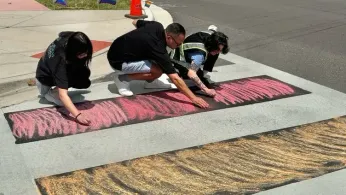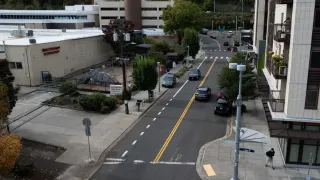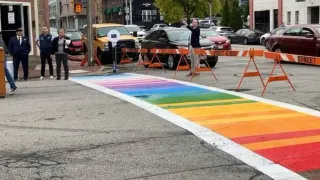
Aug 25
Community Restores Pulse Nightclub Rainbow Crosswalk, State Officials Paint Over Memorial Again in Overnight Action
READ TIME: 3 MIN.
In a deeply symbolic act of resilience, members of the Orlando LGBTQ+ community and allies repainted the rainbow crosswalk outside the former Pulse nightclub in the early hours of Saturday morning. The crosswalk, originally installed in 2017 to honor the lives lost in the Pulse tragedy, has become a touchstone for community grief and pride. Their efforts came just days after the Florida Department of Transportation (FDOT) painted over the memorial, sparking outrage and protest among local residents and elected officials .
Florida State Senator Carlos Guillermo Smith, a longtime advocate for LGBTQ+ rights, shared a video on social media documenting the restoration. “I just discovered that in the dark of night, the Orlando community showed up to the crosswalk outside of Pulse nightclub and they painted it back its original rainbow colors,” Smith said, praising the citizen-led effort and highlighting the importance of the site to the city’s queer community .
However, the restoration was short-lived. By the following evening, FDOT returned under the cover of darkness and once again painted over the rainbow crosswalk, erasing the colors that had come to represent both community mourning and joy . The move has prompted renewed protests, emotional responses from survivors and families of victims, and condemnation from local leaders.
The removal of the rainbow crosswalk galvanized hundreds of Orlando residents. On Thursday evening, a crowd gathered at the intersection of West Esther Street and Orange Avenue, the site of the former Pulse nightclub, to protest FDOT’s decision. Protesters waved large Pride flags, held signs, and used chalk to temporarily restore the crosswalk’s vibrant hues. Messages like “You can’t erase our joy” were scrawled across the pavement, reflecting the community’s determination to honor the memory of the 49 victims of the Pulse shooting .
Among the demonstrators was Alexis Bishop, a 29-year-old pansexual Orlando resident, who wrote “Queer joy rest love resistance!” in chalk. Bishop described the removal as “upsetting more than anything,” noting, “We all sit here. We're stunned, because why? Why cover it? We got the necessary permission in the first place to have it” .
U.S. Representative Maxwell Frost, D-Orlando, addressed the crowd, describing the state’s actions as “a violent act on our community. It's an act of vandalism in the middle of the night, and just like the ICE agents terrorizing our communities wear the masks because they know they're not proud of what they're doing, that's why they did this in the dead of the night” .
Orlando Mayor Buddy Dyer also condemned the removal, calling it "a cruel political act" that further wounded a community still healing from the Pulse tragedy .
The dispute over the Pulse crosswalk is part of a broader statewide crackdown on rainbow crosswalks. Earlier this month, FDOT sent letters to cities including Delray Beach and Key West, ordering the removal of similar rainbow markings by September 3rd, citing alleged safety and regulatory concerns . State officials claim that non-standard roadway markings could pose a hazard and threaten to withhold funding from municipalities found in violation .
Local leaders and activists have pushed back, arguing that the crosswalks have been safely integrated for years and serve as vital symbols of visibility and inclusion. Many see the sudden enforcement as part of a larger pattern of anti-LGBTQ+ policy moves under Governor Ron DeSantis’s administration .
The Pulse nightclub, where 49 people were killed in a mass shooting on June 12, 2016, remains a deeply important memorial for Orlando’s LGBTQ+ community and allies worldwide. The rainbow crosswalk, installed one year after the tragedy, was meant to serve as a visual reminder of both the loss and the enduring spirit of the community .
For many, the ongoing battle over the crosswalk’s existence is emblematic of larger struggles for recognition, safety, and dignity. “Queer joy is resistance,” Bishop said during the protest, emphasizing the crosswalk’s role in affirming LGBTQ+ lives and histories .
As the story has gained national attention, advocates are calling for state and local leaders to find a solution that honors both regulatory standards and the need for memorialization. Some have proposed alternative designs or nearby installations that would not conflict with FDOT rules, while others insist that the rainbow crosswalk itself is the most authentic tribute to the victims and survivors of Pulse .
The Orlando community continues to organize, with plans for further demonstrations and public forums in coming weeks. As the debate unfolds, the Pulse crosswalk remains a powerful symbol—not only of tragedy, but of the enduring demand for LGBTQ+ visibility, remembrance, and joy.






